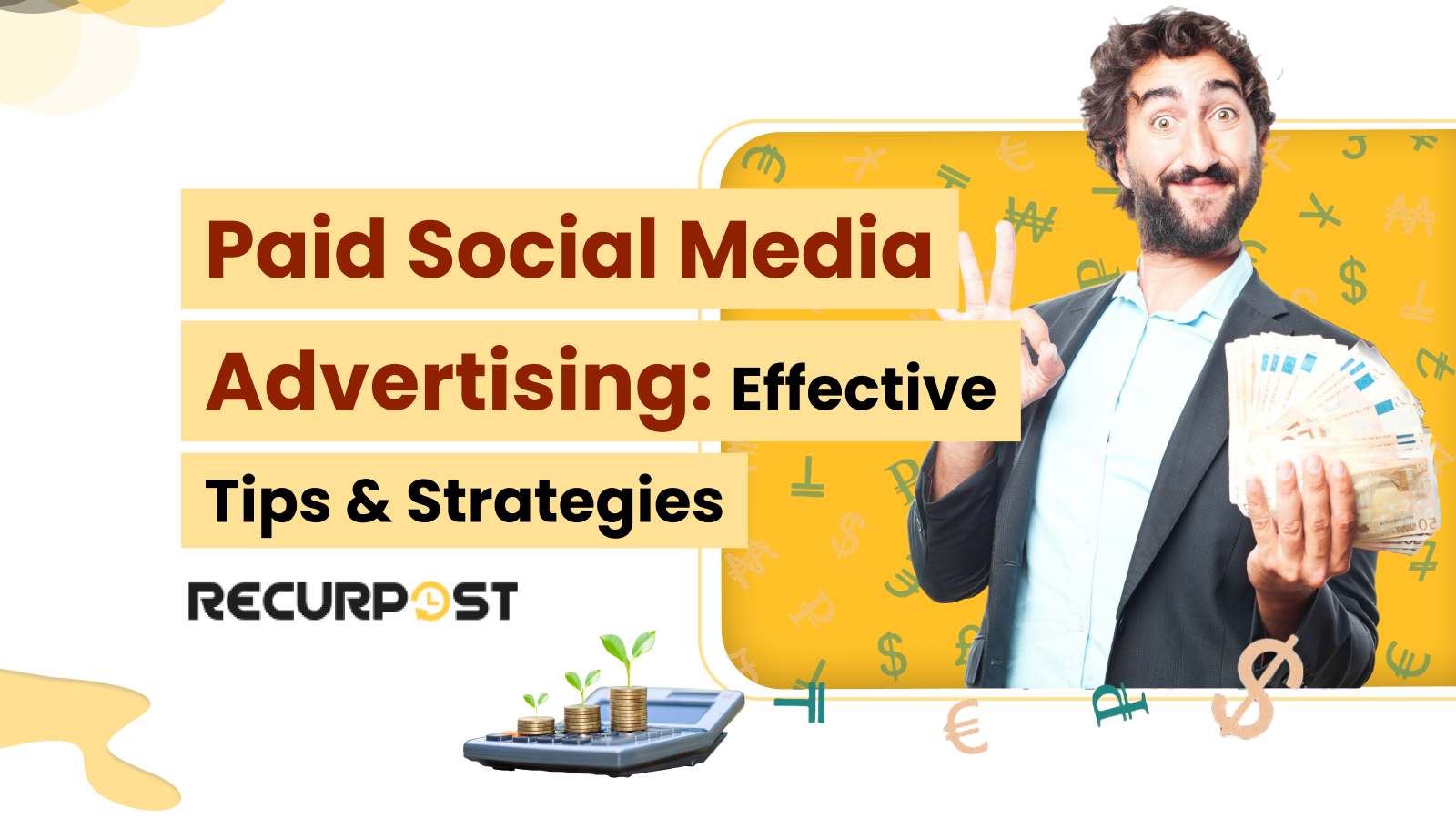If you run a small business, paid social media advertising can be a core part of your marketing. Platforms like Facebook, Instagram, LinkedIn, and TikTok help brands gain visibility, spark engagement, and drive sales. Success comes from running ads with purpose, clear budgets, strong creative, and the right platform for each campaign.
In this post, we’ll cover the essentials of paid social media advertising. You’ll see ad examples, practical tips, and the most useful platforms for growing your reach. By the end, you’ll know how to boost results for your own brand or for client campaigns using paid social media advertising.
Curious where to begin? Let’s walk through what makes social media ads work in today’s market.
Global social media ad spending continues to climb. Reports show paid social media advertising will grow at an average annual rate of 10.78%, hitting $406.50 billion by 2029. This surge reflects how brands of all sizes now treat paid social media advertising as a core driver of growth.
Differences Between Organic and Ad Posts
Organic posts reach people without paid promotion. They build community, spark conversation, and maintain a steady presence on social platforms. Ad posts, on the other hand, use paid social media advertising to expand reach beyond existing followers. They run with set budgets, clear campaign objectives, and measurable results such as click-through rate (CTR) or conversions.
The real value comes from balancing both. Organic content strengthens trust, while social media ads push brand visibility, drive traffic, and generate leads at scale.
| Aspect | Organic Posts | Ad Posts |
| Reach | Limited to followers and their network. | Broader, includes targeted non-followers. |
| Cost | Free to publish. | Paid, requires a budget. |
| Targeting | No specific targeting; relies on algorithms. | Precise targeting (demographics, interests). |
| Objective | Builds relationships and engagement. | Focused on goals like traffic or sales. |
| Analytics | Basic metrics (likes, shares, comments). | Detailed performance tracking. |
| Longevity | Visibility fades with algorithm changes. | Visible for the paid duration. |
Paid Social Media Advertising Budgets
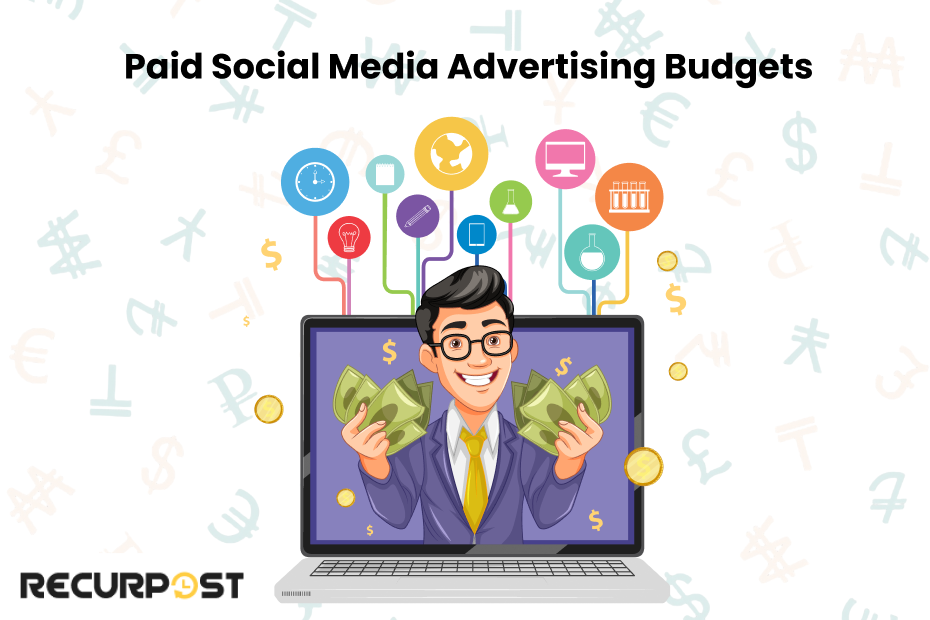
On paid social platforms, the first step in paid social media advertising is setting a clear ad budget. Without one, businesses risk overspending or missing growth opportunities. The goal is to decide how much to spend on each campaign and platform while keeping return in mind.
Budgeting for paid social media campaigns starts with knowing the cost structure of each platform. Facebook ads and Instagram ads often use cost-per-click (CPC) or cost-per-impression (CPM) pricing. That means you pay when someone clicks or when the ad is displayed.
Final budget decisions depend on ad costs, audience size, and campaign goals. Some brands also track cost per acquisition (CPA) and return on ad spend (ROAS) to measure efficiency. A daily budget or testing budget helps manage spending while gathering performance data.
Average Social Media Advertising Expenses
Average costs for paid social campaigns help guide budget planning. Below is a breakdown of cost-per-click (CPC) and cost-per-impression (CPM) across major platforms:
| Platform | Average CPC | Average CPM |
| $0.97 | $7.19 | |
| $1.20 | $7.91 | |
| $5.26 | $6.59 | |
| $0.50 – $2.00 | $6.46 | |
| TikTok | $1.00 – $3.00 | $10.00 – $12.00 |
These rates show average paid social media advertising costs, but final spend depends on audience targeting, industry, and campaign type. When planning your paid social media advertising strategy, always consider these averages as starting points. Some advertisers also track cost per lead (CPL) and return on ad spend (ROAS) to evaluate performance.
Reviewing costs within your industry and audience segment gives a clearer estimate for budgets and helps fine-tune future paid social media advertising spend.
How Much Does Social Media Marketing Cost for Small Businesses
How Much Should You Spend on Social Ads?
Budgets vary by campaign size. Small tests may start with a few hundred dollars, while large campaigns can run into thousands. The exact spend depends on platform, audience size, and campaign goals. Start with a testing budget: dedicate a small share to trial different ad creatives, audience targeting, and platforms. A/B testing shows which ads perform best before scaling your paid social media advertising efforts with a larger daily budget.
Track results with clear metrics. Monitor CPC, CPL, CPA, CTR, and ROAS to see which ads deliver conversions. Increase spend on strong performers and reduce spend where returns fall short. Ongoing testing and adjustments keep campaigns on track and prevent wasted spend.
Budgeting for Paid Social by Business Type
| Business Type | Monthly Budget | Strategy |
|---|---|---|
| Small Biz | $300–$1,000 | Focus on retargeting + one platform |
| Mid-size | $1,000–$5,000 | Run 2–3 platform tests, A/B creatives |
| Enterprise | $10,000+ | Omnichannel ads with automation + reporting dashboards |

A common split is to place 70% of your budget on the best-performing platform and 30% on testing new ads or audiences. Many brands also adjust seasonally, such as boosting spend in Q4 for eCommerce campaigns when competition and demand are highest.
Benchmarks to Keep in Mind for Paid Social Platforms
Here are average performance benchmarks across paid social media advertising platforms. These ranges help advertisers compare CPC, CPM, CTR, ROAS, and CPA when planning social media ads.
| Platform | CPC Range | CPM Range | Notes |
| Facebook Ads | $0.50 – $3.00 | $5 – $15 | Costs vary based on industry and targeting. |
| Instagram Ads | $0.50 – $3.00 | $5 – $15 | Pricing is similar to Facebook, but can be higher for younger audiences. |
| LinkedIn Ads | $2.00 – $7.00 | Not Available | Ideal for B2B marketing; more expensive |
| TikTok Ads | $1.00 – $3.00 | $10.00 | Pricing varies significantly, with CPM rates typically higher than other platforms. |
How to Track and Report Paid Social Ad Spend
- Track spend in tools like Meta Ads Manager, LinkedIn Campaign Manager, and TikTok Business Center.
- Monitor key metrics in your paid social media advertising, total spend, CPC, CTR, ROAS, CPA, plus conversions.
- Break down reports by platform, campaign, audience segment, and date range for deeper insights.
- Build custom dashboards in Google Data Studio or HubSpot to unify reporting across platforms and effectively track your paid social media advertising efforts.
- Reports should drive action: reallocate the daily budget, pause underperforming ads, and adjust campaigns for stronger results.
Effective Paid Social Media Advertising Strategies
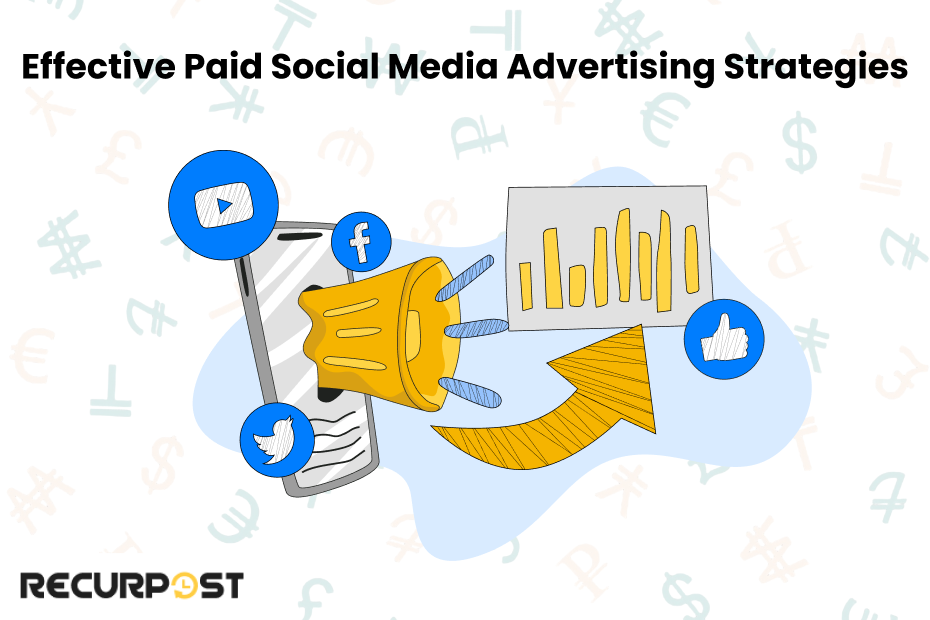
Running a paid social media campaign takes more than good visuals or a large budget. Success depends on matching the right ads with the right people, tracking results, and refining as you go.
Here are practical methods that help campaigns reach the right audience and deliver measurable results:
1. Target the Right Audience
Paid social platforms allow detailed audience targeting. You can segment by demographics (age, location, interests), behaviors (shopping activity, site visits), or job titles. LinkedIn ads work well for professional targeting, while Facebook ads and Instagram ads cover broader interests.
2. Run A/B Tests on Ads
Start with a testing budget and run variations of ad copy, visuals, and CTAs in your paid social media advertising. Compare carousel ads vs single-image ads, or story ads vs feed ads, to see which formats drive stronger CTR and conversions.
Examples:
- Test different videos or images to see which gains higher engagement.
- Compare CTAs such as “Shop Now” vs. “Learn More.”
- Try different ad formats to spot which combination lowers CPC or raises ROAS.
Testing builds data that guides better budget allocation.
3. Retargeting for Conversions
Retargeting in paid social media advertising shows ads to users who have already interacted with your brand. This boosts the chance of conversions, such as purchases, sign-ups, or downloads. On platforms like Facebook ads and Instagram ads, you can build custom audiences or lookalike audiences to reach people who match your current buyers. Retargeting lifts CPA performance and drives repeat visits.
4. Match Platforms to Campaign Goals
Each social media platform serves different campaign goals based on its unique strengths and audience characteristics. For example:
- Facebook ads and Instagram ads: great for reach, engagement, and lead generation.
- LinkedIn ads: best for B2B targeting and professional audiences.
- TikTok ads and YouTube ads: strong for brand awareness, viral campaigns, and product discovery through short-form or video-first ads.
Choosing platforms by goal ensures your campaign budget delivers the best results.
5. Create Ads That Connect with the Audience
Strong ad creatives for paid social media advertising use high-quality visuals: short videos, carousels, or mobile-friendly images. More than design, the ad copy and CTA should connect with the audience needs. Tailor your visuals and wording to your target audience, whether that’s professionals, students, or niche groups. This raises engagement and improves conversion rate.
6. Advanced Paid Social Techniques
- Creative Rotation: refresh visuals every 10–14 days to prevent fatigue.
- Audience Layering: mix lookalike groups with behavioral segments.
- Bid Strategy Tuning: Try manual bidding for high-intent audiences.
- Cross-Platform Learnings: reuse top ad copy across platforms like LinkedIn or YouTube.
- Landing Page Testing: align ad copy with landing pages to improve conversions and lower CPC.
How to Build a Paid Social Media Advertising Strategy
Step 1: Define Objectives: Decide on goals such as brand awareness, lead generation, or sales. Link each to measurable KPIs like CTR, conversions, or ROAS.
Step 2: Know Your Audience: Build personas and use demographic, interest, and behavioral targeting to refine your reach.
Step 3: Pick the Right Platform: For paid social media advertising, choose based on campaign goals. LinkedIn ads for B2B, Instagram ads for Gen Z, TikTok ads for product discovery.
Step 4: Craft Creatives: Use ad copy, CTAs, and visuals that fit each platform and target audience. Add mobile optimization for better performance.
Step 5: Set Budgets and Bids: Split spend between a testing budget and a larger daily budget. Adjust by campaign type and bidding method (CPC, CPM, CPA).
Step 6: Track & Analyze: Install Facebook Pixel or platform tags, add UTM parameters, and monitor conversions in dashboards like Google Data Studio.
Step 7: Optimize: In paid social media advertising, reallocate spend based on results. Rotate creatives, fine-tune bids, and adjust audience segmentation for better ROI.
Top Paid Social Media Advertising Platforms
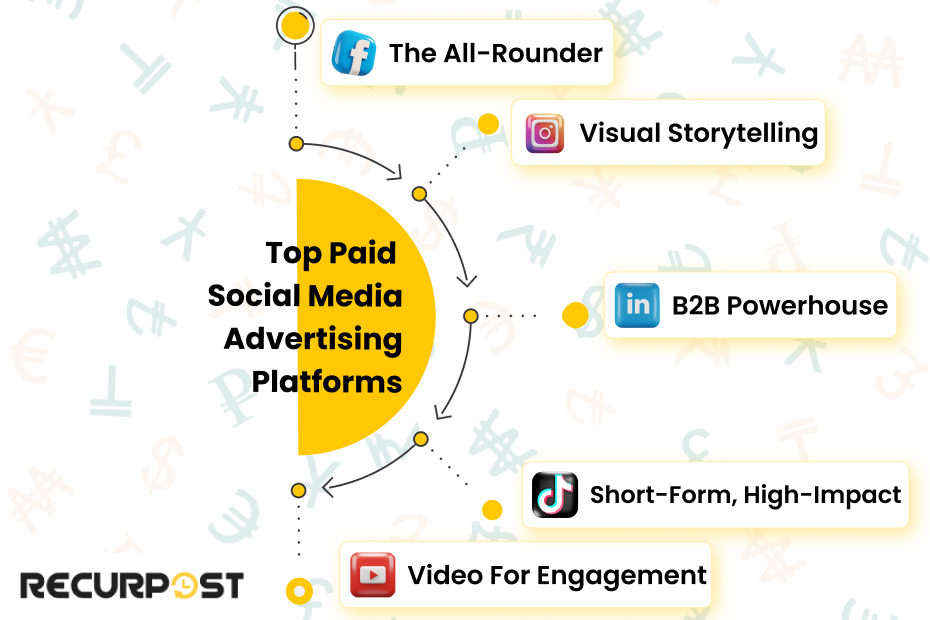
Deciding where to spend budget on paid social media advertising can feel overwhelming. Each platform fits different goals, audiences, and campaign types.
Here’s a breakdown of the top paid social platforms and how businesses use them:
1. Facebook Ads: The All-Rounder
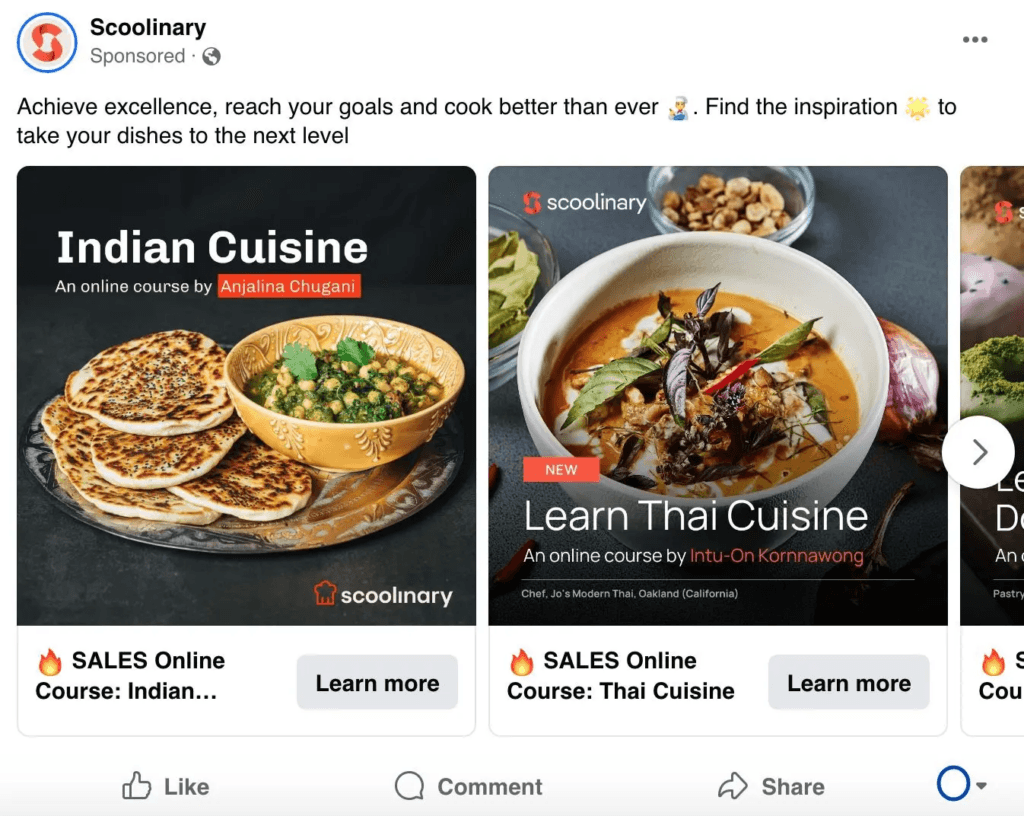
Source: Semrush
Facebook is still one of the most widely used paid social media advertising platforms, with over 2.9 billion active users. Facebook ads allow targeting by location, demographics, interests, and behaviors, making it versatile for businesses with large or niche audiences.
Why advertisers choose Facebook Ads:
- Wide range of formats, including carousel ads, video ads, and story placements.
- Automated delivery system improves reach and targeting accuracy.
- Facebook Pixel tracks conversions and enables retargeting for stronger ROAS.
Best for: brand awareness, lead generation, and eCommerce campaigns.
2. Instagram Ads: Visual Storytelling
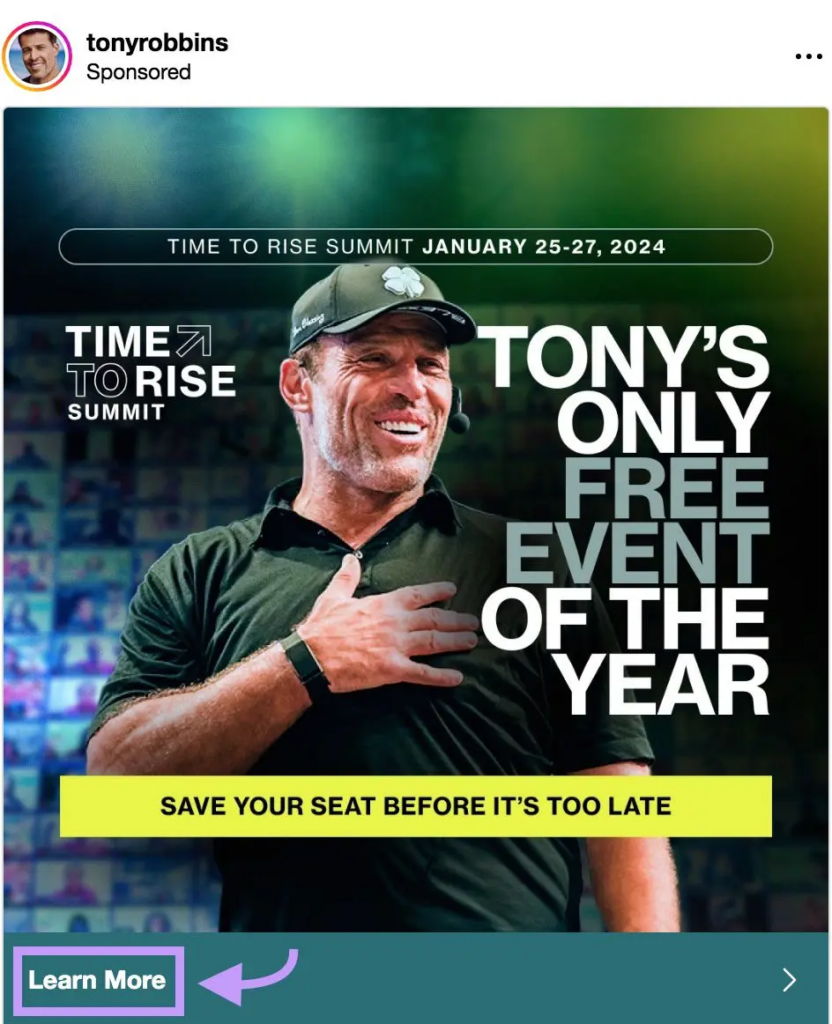
Source: Semrush
If your target audience leans younger (Gen Z or Millennials), Instagram is one of the strongest paid social media advertising options. The platform is highly visual, making it ideal for brands that showcase products, services, or experiences through images, Reels, or video ads.
Instagram ads run within the feed and Stories ads, blending into the platform experience. Features like Instagram Shopping enable purchases directly in the app, shortening the path to conversions.
Why advertisers choose Instagram Ads:
- Engagement-driven features like Stories ads, Reels ads, and influencer partnerships build awareness and interaction.
- Targeting options mirror Facebook ads, since both platforms share Meta Ads Manager.
- The visual-first format lets brands present products in creative and immersive ways.
Best for: brand awareness, product discovery, and driving sales, especially in industries such as fashion, beauty, and food.
3. LinkedIn Ads: B2B Powerhouse
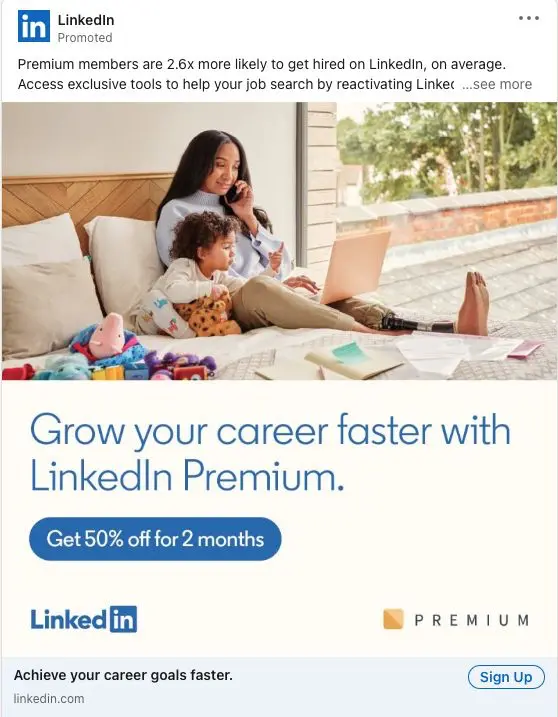
Source: Semrush
LinkedIn is the go-to platform for reaching professionals. With more than 700 million users, LinkedIn ads excel at B2B targeting, helping brands connect with decision-makers across industries. Ad formats include sponsored content, message ads, and dynamic ads. These allow precise targeting by job title, company, industry, and seniority.
Why advertisers choose LinkedIn Ads:
- Advanced audience targeting helps reach professionals and company leaders.
- Built for lead generation, with Lead Gen Forms that capture data inside the platform.
Best for: B2B lead generation, recruitment ads, and thought leadership campaigns.
4. TikTok Ads: Short-Form, High-Impact
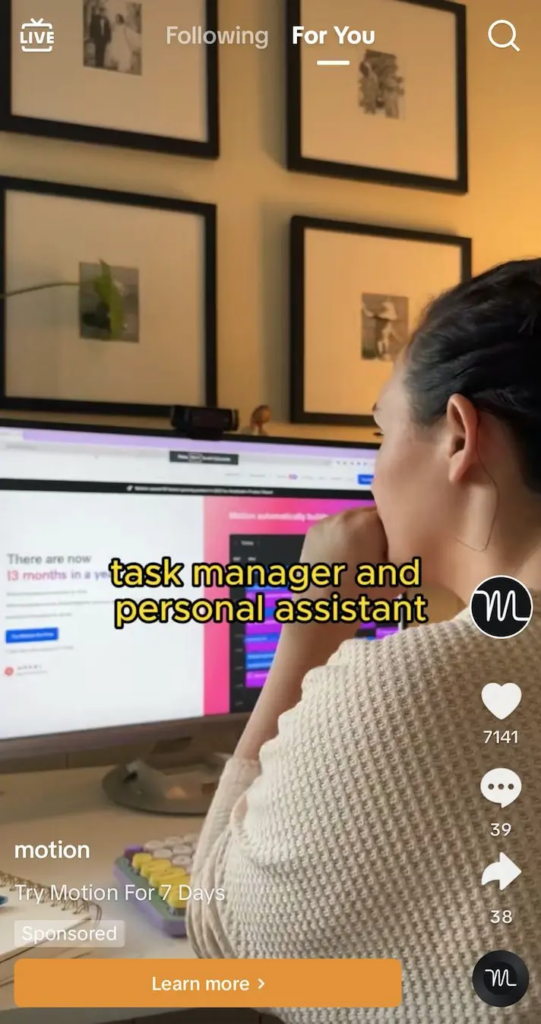
Source: Semrush
TikTok is one of the fastest-growing platforms for paid social media advertising, especially for younger audiences such as Gen Z. Its short-form, creative content makes it a strong choice for brands that want to entertain and capture attention. TikTok supports in-feed ads, branded hashtags, and branded effects, giving advertisers interactive formats to run paid social campaigns that encourage participation.
Why advertisers choose TikTok Ads:
- High engagement, particularly for videos that look natural and blend into the feed.
- Brands can launch viral challenges, motivating users to create content with their products.
- In-feed ads appear native to the platform, increasing user attention without interrupting the experience.
Best for: brand awareness, product discovery, and viral marketing campaigns.
5. YouTube Ads: Video for Engagement
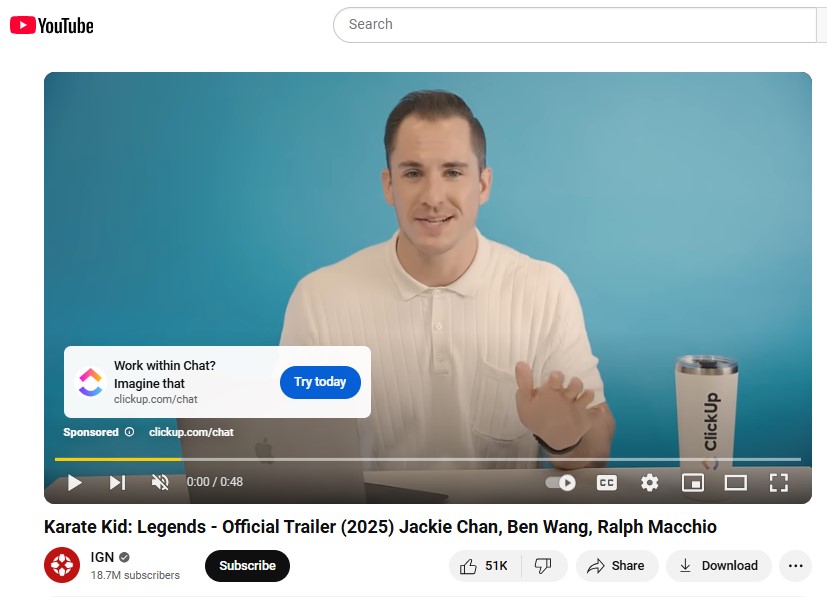
YouTube is the leading platform for video content, with more than 2 billion monthly active users. It works well for brands that want to run video ads in an immersive, long-form format. Ad options include skippable ads, non-skippable ads, bumper ads, display ads, and TrueView ads, giving flexibility based on campaign goals.
Why advertisers choose YouTube Ads:
- Video ads allow brands to reach users with engaging stories and product showcases.
- With TrueView ads, payment occurs only if viewers watch 30 seconds or interact with the ad.
- YouTube targeting allows refined filters such as demographics, interests, search history, and platform behavior.
Best for: brand awareness, product demos, and driving website traffic.
Learn More About Best Social Media Marketing Apps for 2025
Paid Social Media Advertising Examples
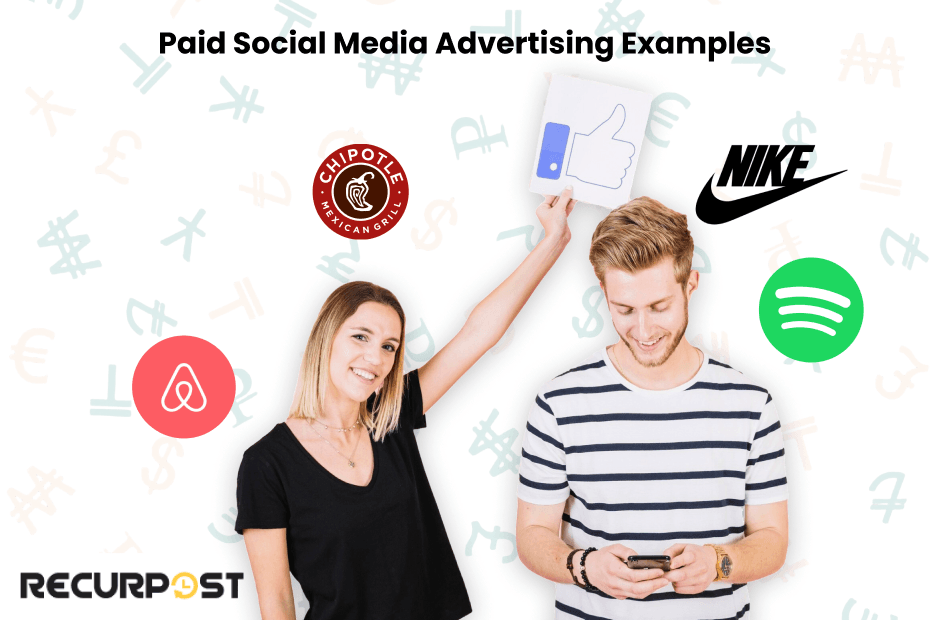
These paid social media advertising examples show how brands use ad creatives, CTAs, and audience targeting to drive engagement and conversions. Real-world use cases help illustrate the variety of approaches in paid social media advertising today.
1. Airbnb (Facebook Ads): Airbnb runs Facebook ads with standout ad creatives that appeal to travelers looking for memorable stays. Ads are refined with audience targeting filters, narrowing by interests, demographics, and behaviors.
2. Nike (Instagram Reels): Nike partners with influencers to create short-form Instagram Reels ads that showcase products in action. These ads build brand awareness and drive product sales, supported by Instagram Shopping.
3. Chipotle (TikTok Ads): Chipotle launched the #GuacDance TikTok campaign, inviting users to join a challenge for free guacamole. The viral format boosted CTR, engagement, and conversions among Gen Z audiences.
4. Spotify (Personalized Ads): Spotify runs personalized ads based on listening history, showing concert promotions and music offers. By tailoring ads to user behavior, Spotify improves CPA and ROAS while keeping ads relevant.
5. Canva (LinkedIn Ads): Canva uses carousel ads on LinkedIn ads, targeting design professionals and marketers by job title. The B2B targeting strategy highlights collaboration and drives qualified lead generation.
6. Glossier (Instagram Shopping Ads): Glossier runs Instagram Shopping ads with high-quality visuals linking directly to product pages. Ads target beauty fans and use ad creatives designed to lift conversions.
7. Monday.com (YouTube Ads): Monday.com creates YouTube pre-roll ads with short demos of its project management platform. These skippable ads target business users and showcase solutions for workflow challenges, raising CTR and conversions.
8. Gymshark (Facebook Retargeting Ads): Gymshark runs retargeting ads on Facebook, showing dynamic product ads to users who viewed items but didn’t purchase. Limited-time discounts and reviews improve conversion rate and lower CPC.
Paid Social Media Ads Best Practices: Do’s and Don’ts
Strong paid social media advertising campaigns rely on practical methods and consistent tracking. Below are the dos and don’ts that keep ad spend efficient and results measurable.
Dos for Successful Paid Social Media Ads:
| Best Practice | Why It Works | Tip |
| Use High-Quality Visuals | High-quality visuals capture attention and increase engagement. | Always use high-resolution images. Ensure they are sized properly for each platform and reflect your brand’s style and message |
| Test Multiple Variations | A/B testing helps you find what works best with your target audience. | Test one variable at a time (e.g., test two headlines or two images). Keep other elements constant for accurate results. |
| Focus on a Single, Clear CTA | A single, concise CTA helps guide the audience toward the desired action. | Keep your CTA simple and direct, such as “Shop Now” or “Learn More.” |
| Use Detailed Audience Targeting | Highly targeted ads resonate more with the right target audience, boosting engagement and conversions. | Use demographic, interest, and behavioral targeting. Consider retargeting people who have interacted with your brand. |
| Monitor Analytics Regularly | Analytics provide valuable insights into what’s working and what’s not. | Track key performance indicators (KPIs) like CTR, conversion rates, and ROAS to optimize your campaigns. |
Don’ts for Avoiding Pitfalls in Paid Social Media Ads:
| Mistake | Why It’s a Mistake | Tip |
| Overloading Ads with Text | Too much text can make your ad cluttered and difficult to read, reducing engagement. | Limit text to 20% of the image area. Keep the text minimal and let the visuals communicate the message. |
| Ignoring Mobile Optimization | A large portion of social media activity is mobile, so unoptimized ads can have a high bounce rate. | Test your ads on mobile devices before launch. Ensure your text is legible and your visuals are cropped correctly for smaller screens. |
| Running the Same Ads for Too Long | Repetitive ads can lead to ad fatigue, reducing engagement and performance. | Refresh your creatives regularly and rotate ads to keep the audience engaged. |
| Relying Only on One Platform | Focusing on just one platform can limit your audience reach. | Spread your paid social strategy across platforms like Facebook, Instagram, LinkedIn, and TikTok to reach a broader audience. |
| Ignoring Platform-Specific Guidelines | Every platform has unique ad specs and guidelines. Ignoring them can lead to poor performance or ad disapproval. | Familiarize yourself with the ad guidelines of each platform to ensure your ads are optimized for them. |
To Conclude
Strong paid social media advertising campaigns combine planning, testing, the right tools, and steady adjustments. Success comes from eye-catching ad creatives, refined audience targeting, smart budget allocation, and consistent tracking of results such as CTR, CPC, CPM, and ROAS.
Success in paid social media management comes from adapting ads to match each platform format and staying flexible enough to adjust based on performance. By following best practices and avoiding common errors, your business can improve conversions and achieve stronger ROI for clients.
The world of paid social media advertising can feel overwhelming, but with a defined plan, the right tools, and ongoing testing, your business is positioned to get more from advertising in digital marketing.
FAQs on Paid Social Media Advertising
1. What is the difference between CPC and CPM?
CPC (Cost Per Click): You pay each time someone clicks your ad, useful for traffic and conversions.
CPM (Cost Per Thousand Impressions): You pay for impressions, best for brand awareness.
2. How can I refine ad targeting for stronger results?
– Apply audience segmentation by demographics, interests, behaviors, or job titles.
– Use lookalike audiences to expand reach.
– Test multiple segments and measure CTR, CPC, and conversions to identify the best audience.
3. What’s the best platform for paid social media advertising in 2025?
Facebook ads and Instagram ads: consumer-focused, broad demographics.
LinkedIn ads: strong for B2B targeting and job title filters.
TikTok ads: short-form video for younger, engaged users.
4. How much should I allocate for my first paid social campaign?
Begin with $300–$500. This testing budget lets you try ad creatives, targeting, and platforms before scaling spend.
5. How can I reduce the cost of paid social media advertising?
– Raise engagement to improve platform scoring.
– Use A/B testing on ad copy, creatives, and targeting.
– Adjust your bidding strategy (switch between CPC, CPM, or CPA) based on goals.
6. How do I know if my paid social media advertising campaign is successful?
Match KPIs to goals:
Traffic: monitor CPC and CTR.
Leads: track Cost Per Lead (CPL).
Sales: monitor ROAS and conversion rates.
7. What are the risks of overspending on social ads?
Overspending without tracking can waste budget and lower ROI. Set clear goals, monitor results, and run A/B testing before scaling.
8. Can I run paid social media ads with a small budget?
Yes. Platforms like Facebook, Instagram, and Twitter allow small daily budgets. Start with testing and scale based on results.
9. When should I use CPC vs CPM?
Use CPC for direct response (clicks, conversions).
Use CPM for brand awareness.
10. How do I refine ad creatives for stronger performance?
– Use high-quality visuals such as short videos or sharp images.
– Write concise ad copy with a clear CTA.
– Test formats like carousel ads, video ads, and single-image ads.
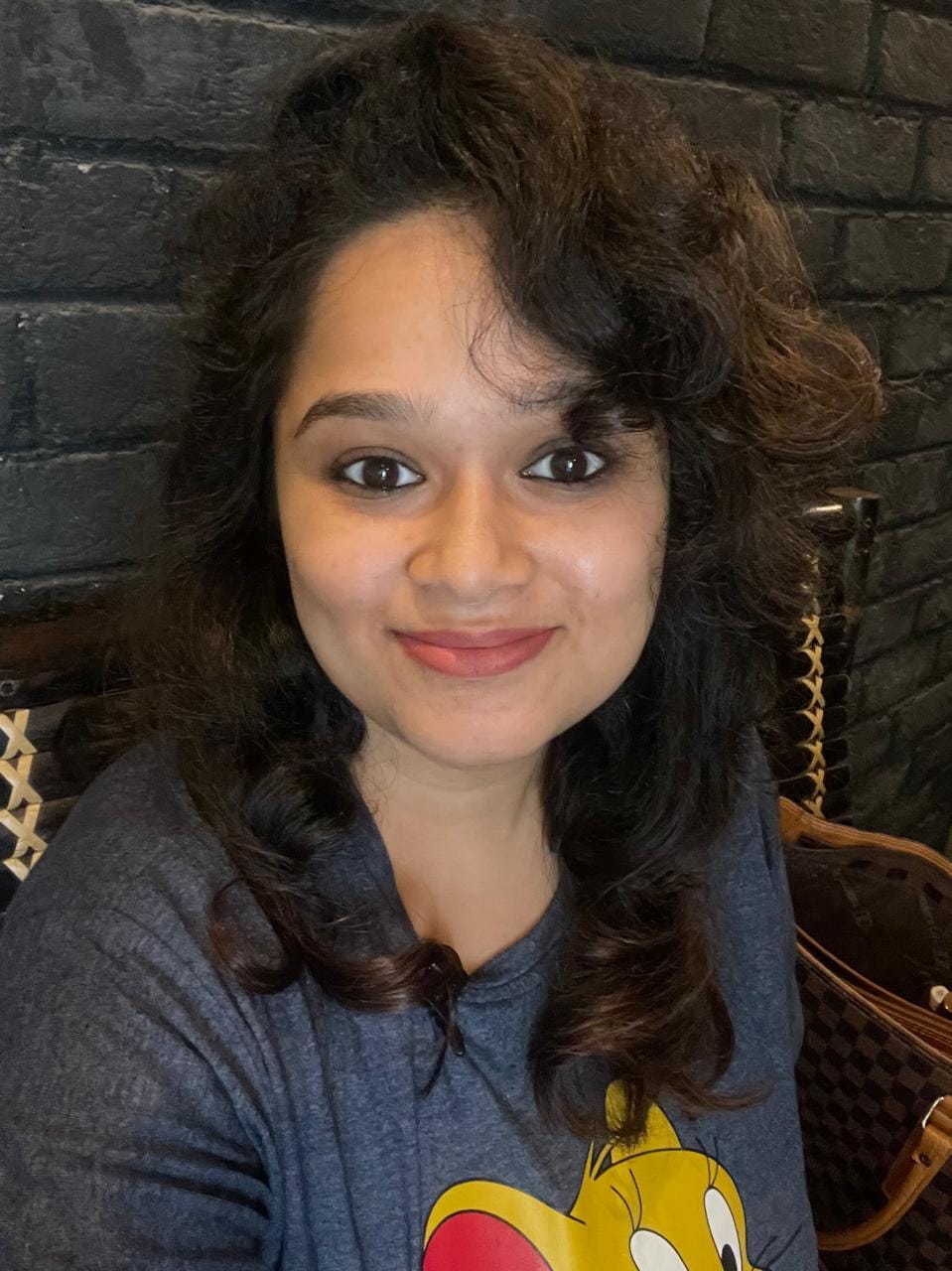
Ruchi Dhimar is a skilled content writer with 5 years of experience. She is passionate about crafting compelling narratives, specializing in writing content for different industries.

